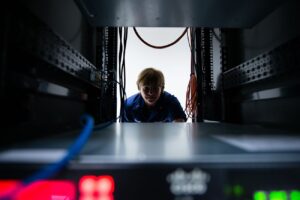How Working Remotely Increases Chances of Cyber-attacks – How to Address The Threats

Asked to work from home … what are your first thoughts? Are you happy? Are you free? Or are you worried about how you will be able to cope with the changes in the environment? Hundreds of questions came to our minds when we were asked to work remotely.
No one said things would be easier. Most of us think that working long distances means relaxing for hours, or being more comfortable with PJs, but do you think that everything will be sun and rays?
Hate being a bearer of bad news, but there is a lot you need to take care of when you work remotely. The weight on your shoulders will double, you will be asked to carry more than you can chew.
And what really brought things down tenfold … insecurity!
Yes, that’s right. If you don’t pay attention to how you handle your remote work situation, things can go smoothly, especially in the wake of cyber attacks.
Yes, working from home has its residents, I hope so, but why not build a safe place for yourself? You are trusted with a large number of work files, personal credentials of many overseas customers, or ask to manage a company website. What happens to all of this, when the metal you use is unsafe?
Will you pay for the loss when all of the above is combined?
No. However, you can stop and reduce your chances of becoming a victim of future cyber attacks. However, first let’s talk about what kind of attack you are facing if it is not protected.
What are the risks of cybersecurity for remote workers?
The cyber-world is changing day by day. Hackers come up with new and better ways to steal information, disrupt the system and make huge profits.
It doesn’t matter if you work in an office, you are sent to work remotely, you are an independent person from the beginning of time; it doesn’t matter. Cyber attacks are inevitable and can strike at any time.
However, the risk is high and the situation is getting worse for remote workers, especially now, as the Covid-19 epidemic approaches. Hackers create attacks around the epidemic, making full use of it.
Working from home is very different compared to working in an office. Yes, the job is the same, but no IT or security team is waiting in the next room to help you. You are alone in that place.
Here are some of the cyber attacks that the remote workers seem to be experiencing on a daily basis – what they should be aware of:
Theft of sensitive information
Theft of sensitive information is one of the leading ways to hack someone’s machines and disrupt their activities at the root of the problem. You may have noticed that at some point, you may have received at least one or two emails from “known” sources, asking you to send in your email and password etc.
The email may be recorded in such a way as to cause you to believe that your device or files are already being corrupted, and if you do not provide a ridiculous amount of money, the hijacker will retaliate.
Theft of sensitive information not only takes the form of emails, but can also be sent via text message, post or telephone. The level of scams has improved significantly more recently. And even though you think you will notice, it only takes one careful and discreet email to hit your inbox. Don’t just find out for yourself.
You can lose the overload of important information, money, or make your devices and accounts vulnerable.
Fake security apps
Occupational safety is not taken to your homes. No security team is waiting at the end of the line, so ask for help immediately.
Maybe you end up with a good knowledge of the dangers of cybersecurity working remotely and start taking action in your own hands. Suppose you have no idea which security system you can use and just go for anything that seems “interesting.”
This can create some problems in the long run.
Without research, you have been able to invest your confidence in anti-virus or free VPN. Apps like these can send malware or virus streams
Human attack in the middle
This depends on the type of work your department is delegating. There are times when half the employees work inside the office and half are at home. Also in current situations during the epidemic where everyone is sent to work from home.
It should be a fixed stage where the whole department of the different groups meets with the heads. Suppose a website was set up to discuss the content of a sensitive office, where everyone worked together and shared their ideas.
Now, knowing that the risks of cyber attacks are high for remote workers, and security measures are low, this makes it much easier for a hacker to break into a network, access your account, and present it as a last resort. The gang then works with the manager and staff saying it could be, either. This is a Man-in-the-middle attack.
What can you do, to reduce the risks?
Even though cyber attacks are very high, and even though the risk has consumed many, this doesn’t mean you should just sit back on those PJ stuff and say “So, what’s the point then?”
There are a few safety tips and steps to follow, and spend more time, especially if you would like to reduce your chances of getting infected. Of course:
Research and education
First of all, I do not blame employees who work remotely for not having the basic knowledge of how to handle situations like this. The workplace should have training sessions and educational seminars on cybersecurity measures – what to do and how to manage them.
Even if half of the group works remotely, there is something called Skype or zoom. Include all your employees, because at the end of the day everyone is carrying an important piece of office.
Research plays a major role. Many workplaces do not like to use a lot of energy or resources to work in teaching seminars. Why, though, should that stand the test of time? The Internet is your place to play. Use it to good advantage. Look for different forums and take action on other remote employees who have been in the same situation.
Check out the many user reviews on the most reliable software for wishing to invest in you. Don’t just walk in.
Update your security apps
It doesn’t matter if you just downloaded the security app or if you have it last year, update it! Most security risks arise from outdated applications. Tie holes, keep them clean. There is a reason why renew alerts are constantly attacking our devices.
Older software applications mean less security and older standards allowed to create. It’s very easy to get in.
Use strong passwords and two-factor authentication
When you work remotely, there are some situations where your parents, children, siblings etc. all want to use your pc, laptop or phone. They may even drift unknowingly and open work files.
What happens if they send an email in error, or upload a file incorrectly? This is also part of safety risks. Unless your device is malfunctioned or stolen, the host will not be able to easily access that.
Creating passwords should always be a big deal. Never keep them simple and certainly don’t use the same password for your social accounts and work email.
Save backup
You will never know what goes wrong when you work remotely. Always make sure you back up important data and delete the rest. And when you remove the rest, make sure there is no trace or crumb left behind. You never know when the important thing can be stored in a piece of what you threw away. If it gets in the wrong hands, there is a lot that can be done.
Concluding
Remote operation can raise the bar too high when it comes to security risks and cyber attacks, but why let it be the backbone of your world? Take control and learn how to overcome threats



